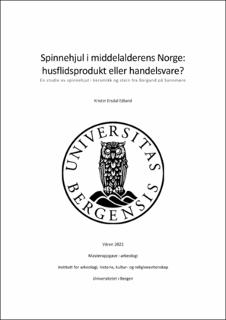Spinnehjul i middelalderens Norge: husflidsprodukt eller handelsvare? En studie av spinnehjul i keramikk og stein fra Borgund på Sunnmøre
Master thesis
Permanent lenke
https://hdl.handle.net/11250/3002304Utgivelsesdato
2022-06-03Metadata
Vis full innførselSamlinger
- Master theses [240]
Sammendrag
This thesis explores the organisation of production of spindle whorls in Sunnmøre, western Norway. It is a sub-study of the Borgund Kaupang Project, and thus it has a bottom-up perspective, seeking knowledge of everyday life at Borgund in the Middle Ages. Within the spindle whorl material there are two material groups that are the focus of this paper: low fired pottery and serpentine. The spindle whorls in low fired pottery seems to have been produced locally for household use. The implication of this is that knowledge about ceramic production has been present in medieval Borgund, despite previous hypotheses on the absence of ceramic production in medieval Norway. The spindle whorls in serpentine seem to have been produced on a larger scale and distributed throughout western Norway. These spindle whorls were probably produced as a trade product. This paper explores methods of discerning professional of specialised production methods in a material where only finished objects and some unfinished products are present through analysis of homogeneity in shape, size, geochemical composition, and qualitative analysis. How quality in spindle whorls can be judged and what connection it has to professionality is also explored.
